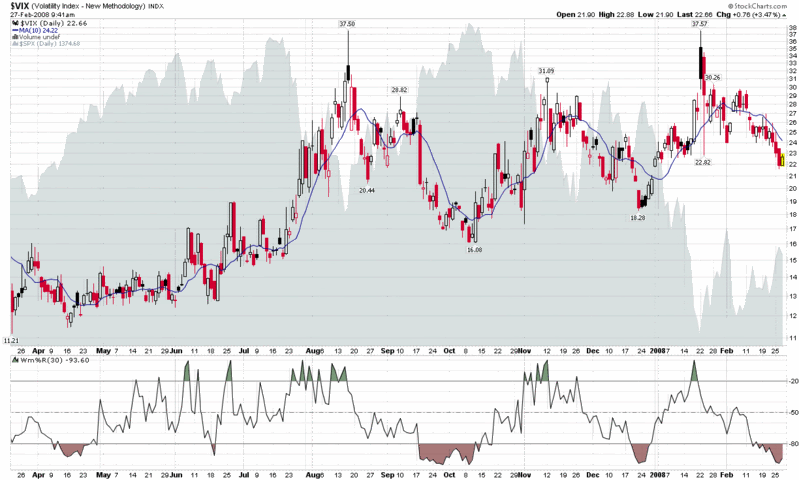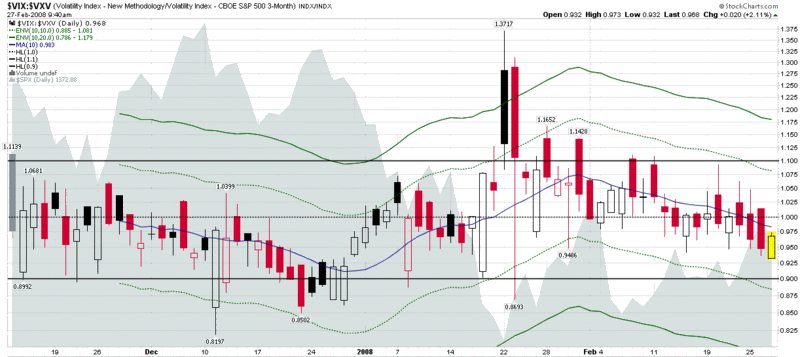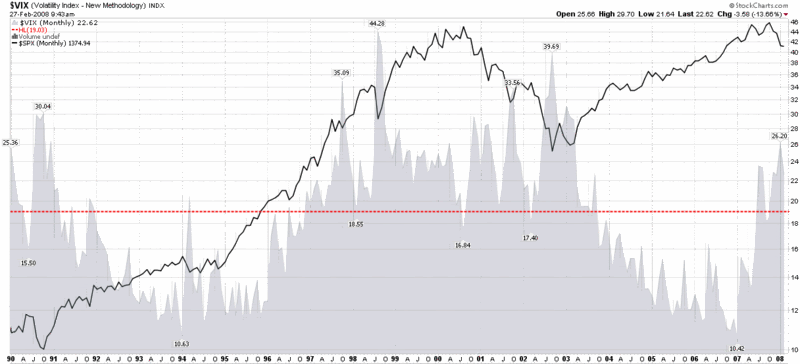The VIX and Going Short
 A reader asked about the feasibility of the declining VIX providing an entry signal for new short positions. Specifically, he noted that his weekly chart of the VIX, which utilizes a 43 week simple moving average, has contained all the action in the VIX over the past year or so, with that 43 week SMA acting as support. Ultimately, his question concerns whether I believe that the 43 week SMA is likely to hold.
A reader asked about the feasibility of the declining VIX providing an entry signal for new short positions. Specifically, he noted that his weekly chart of the VIX, which utilizes a 43 week simple moving average, has contained all the action in the VIX over the past year or so, with that 43 week SMA acting as support. Ultimately, his question concerns whether I believe that the 43 week SMA is likely to hold.
Before I get to the details of that question, let me reiterate my general thinking about using traditional technical analysis on the VIX. In a nutshell, I believe that because the VIX is a derivative (more accurately a derivative of a derivative), traditional technical analysis has only limited validity. This is particularly noteworthy when it comes to support and resistance. If the VIX hits 20, for instance, nobody can rush in and buy the VIX to support it at that level, because one cannot buy and sell the cash VIX. Sure, some may use a VIX of 20 as a rationale for starting to buy VIX options or futures, but the impact of these transactions on the cash VIX is indirect and weak. The impact becomes a little stronger if traders use VIX signals to buy SPX options, but I still prefer to think of the VIX as more of a thermometer than an actual weather phenomenon. Even a major deity would have trouble adjusting the sunshine, clouds and other factors to make the temperature read exactly 60 °F on your back porch.
So my bias is generally against moving averages as providing meaningful support and resistance for the VIX, given that I believe an arithmetic mean of a derivative of a derivative is not a meaningful number. I do believe, however, that previous intermediate and long-term highs and lows in the VIX (e.g., January’s 37.57), round numbers (20, 25, 30, etc.), and deviations of significant magnitude from various moving average (% of 10 day SMA, etc.) can signal (or perhaps even trigger) important psychological milestones and provide high probability entries.
My conclusion, therefore, is that the 43 week SMA is more likely to hold if coincides with a previous low, round number or distance from certain critical SMAs. Given the current numbers, I would say that strong support in the VIX is mostly likely to be found in the 19-20 range.
Just for fun, I have included three charts that provide three very different perspectives on the VIX. The top chart is a basic chart of the VIX going back about a year. As with the major indices, consolidation in the form of a triangle pattern is obvious, but with the VIX, the pattern reaches back to August. The VIX:VXV ratio chart shows the volatility expectations for the next 30 days (VIX) vs. the next 93 days (VXV) – and these are middling at best. The final chart shows a lifetime of the VIX graphed against the SPX, with a horizontal line showing the lifetime mean of the VIX (19.03) thrown in for good measure. There are a number of potential conclusions to draw from these charts, but when I add them all together I come out neutral on the VIX, at least for the short to medium term time frame.
As an aside, when it comes to initiating new short positions, I don't like getting short until at least the third trading day of a new month, particularly with so much worried money sitting on the sidelines. Finally, in terms of support and resistance, I prefer to use the broad equity indices instead of the VIX to time entries and would watch SPX 1410 and NDX 1900 more closely than the VIX, but keep a weather eye on a VIX of 19.





8 comments:
I should probably devote an entire post to Rob Hanna of Quantifiable Edges on Do Reliable Oscillations In The VIX Make VIX Options An Easy Profit Vehicle?, but in the event that I do not (I've had a fairly heavy travel schedule as of late), I encourage everyone to check out the original.
Rob is doing excellent work in his aptly named new blog and should be required reading for any serious student of the market.
Cheers,
-Bill
For those interested in the difference between trading VIX futures and VIX options along the lines suggested by Rob's study, Adam at Daily Options Report has a post that generated a number of interesting comments on the subject: Trading the VIX
If I can, I'll try to work this stuff into a post tomorrow.
Cheers,
-Bill
Durable Goods and New Home sales sucked. Fannie Mae sucked. Plus all of the economic releases yesterday sucked... and the market breaks UP, on a technical break of a Triangle formation.
Check out these simply insane facts, figures and charts.
Bill,
a statistical approach trying to answer the question "to what extend does the S&P 500 match the movement of the VIX, and to what extend does the VIX front month future match the movement of the VIX" could be as follows:
Some basics at the beginning (daily closing settlement values only):
VIX:
100day average value: 23.56
1 standard deviation: 3.37
100day maximum: 31.09
100day minimum: 16.12
255day average value: 19.72
1 standard deviation: 5.31
255day maximum: 31.09
255day minimum: 10.58
--------------------------------
VIX front month future:
100day average value: 23.90
1 standard deviation: 2.64
100day maximum: 28.39
100day minimum: 17.06
255day average value: 19.73
1 standard deviation: 5.13
255day maximum: 30.61
255day minimum: 11.44
First observation:
Although average values concerning VIX and VIX front month future are almost identical, the VIX front month future has a smaller standard deviation, and its trading bandwith is smaller than that of the VIX (it does not exactly follow the VIX to its extremes of the respective time frame, currently below 20 and above 30). The VIX front month future therefore seems to have an (small) implied "mean reversion component".
How close does the VIX match the movement of the S&P 500, and how close does the VIX front month future match the movement of the VIX on a day to day basis ?
I use Pearson's correlation coefficient to mathematical/statistical express the correlation between S&P 500, VIX and VIX front future:
Time frame: 5 trading days (rolling basis)
(measured is the correlation between S&P 500 and VIX as well as VIX and VIX front month future for every trading day and the respective last 4 trading days, on a rolling basis)
VIX vs. S&P 500 (Pearson's correlation coefficient):
100day average value: -0.86
1 standard deviation: 0.12
100day maximum: 0.17
100day minimum: -1.00
255day average value: -0.81
1 standard deviation: 0.29
255day maximum: 0.49
255day minimum: -1.00
The 5 day correlation coefficient is currently standing at -0.98, that means during the last 5 trading days VIX and S&P 500 were almost perfectly (negatively) correlated.
On average there is a good (negative of course) correlation between VIX and S&P 500, especially when there is a clear trend in the S&P 500, but sometimes VIX & S&P 500 doesn't seem to be correlated at all, especially on those occasions when the S&P 500 is trading back and forth without any clear trend visible.
Without going into detail I analysed as well the correlation between the consistence of the magnitude (slope) of S&P 500 and VIX movement (usually at or around leverage factor 4).
--------------------------------
VIX vs. VIX front month future (Pearson's correlation coefficient, time frame 5 days):
100day average value: 0.84
1 standard deviation: 0.24
100day maximum: 0.99
100day minimum: -0.45
255day average value: 0.85
1 standard deviation: 0.23
255day maximum: 1.00
255day minimum: -0.45
The 5 day correlation coefficient is currently standing at -0.96, that means during the last 5 trading days VIX and VIX front month future were almost perfectly correlated.
VIX vs. VIX front month futures are (on average) at least as well correlated as S&P 500 and VIX itself, and an additional advantage is whenever VIX and VIX front month future seem to be out of sync (e.g. correlation coefficient -0.45 instead of at or around 1.00 at christmas 2007 with the highest
premium of around 4.00 points between VIX front month future and VIX), the VIX front month future usually gives a good indication where the VIX (and the S&P 500 probably as well) will be trading looking forward several days in the future.
Best regards
Frank
I also noticed that the usual technique I use with Bollinger bands (20 day bands, 2 standard deviations) has been a good fit for the current upswing. When we exceed the Bollinger envelope and then move inside it, the next move is usually in the inside direction.
Just to capture the developing dialogue on this subject, Rob, Frank and Adam (Daily Options Report) discuss the systems proposed by Rob and Frank in Trading the VIX: Follow Up
For those who are interested, much of the meat and potatoes is in the comments section.
Cheers,
-Bill
Bill, thank you for the article links... they look interesting, have to study them after I get some sleep, lol.
I agree with you 100% about TA and the VIX... for the most part, it defies common sense that support and resistance levels are applicable to a derivative (VIX futures) of a derivative (VIX) of a derivative (SPX).
Certain TA techniques can make sense -- your MAs, Bollinger bands (as steveinchicago pointed out), the MACD histograms I've used to predict VIX reversals -- but one really has to understand what the TA algorithm is designed to detect AND the nature of the VIX itself. One edutainment promoter totally lost credibility with me by claiming that, because the VIX is a derived value, TA should work even better than on equities... HELLO? lol
I also like Frank's thinking about using the front-month VIX futures as an indicator of the cash VIX direction... I use it myself as part of my decision process whether I want to buy or sell vega.
tnt
one other thing -- I must be sleepy, lol -- I wonder how many 'VIX technicians' are using the correct data from Jan 14th to Feb 15th?
As many of you may recall, the cash $VIX was incorrectly calculated for that period of time because the expiration dates were changed due to the holiday schedule:
CBOE Information Circular IC08-026 (also CFEIC08-002). Does anyone know if the various charting websites have incorporated the corrected data yet?
tnt
Post a Comment